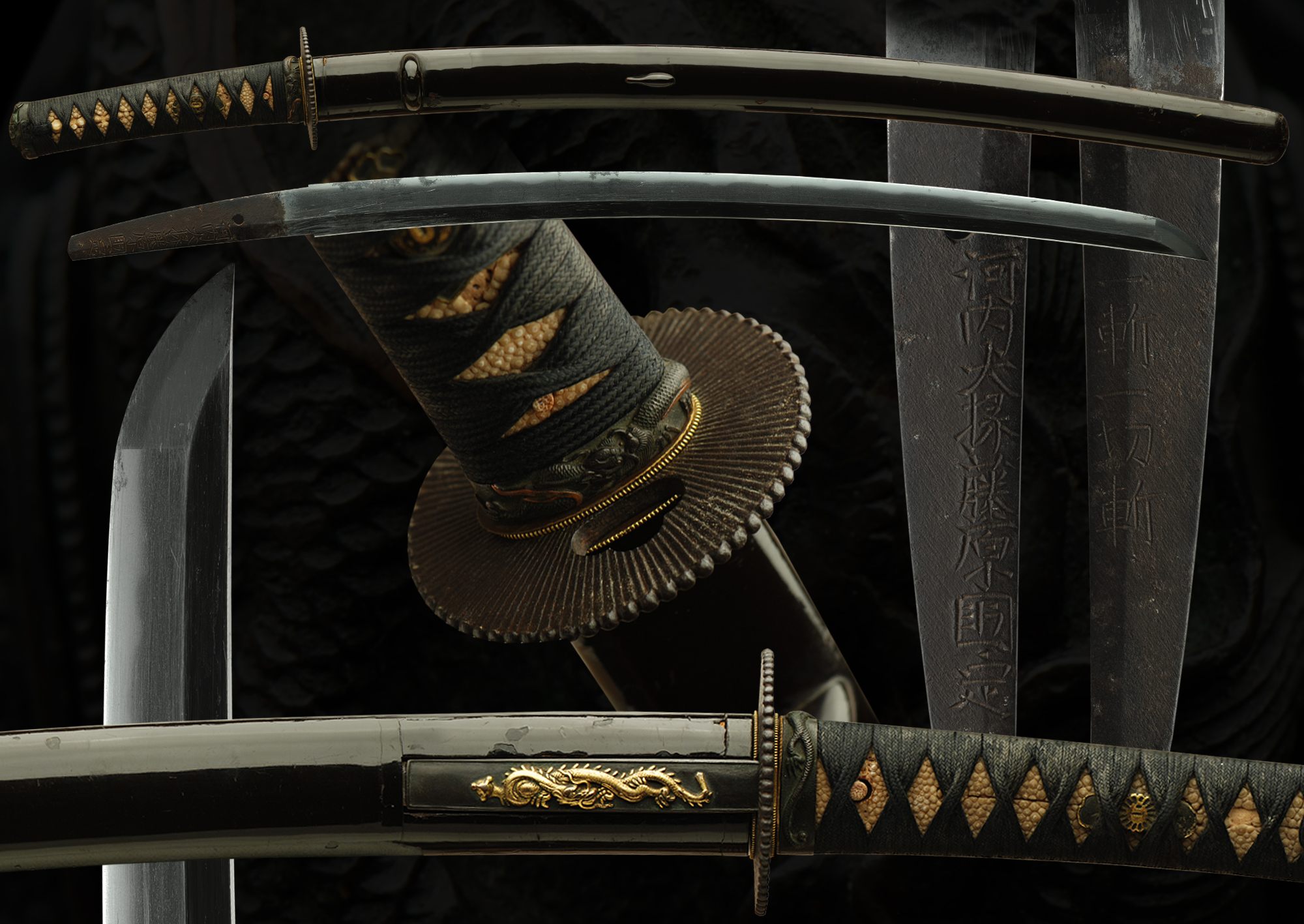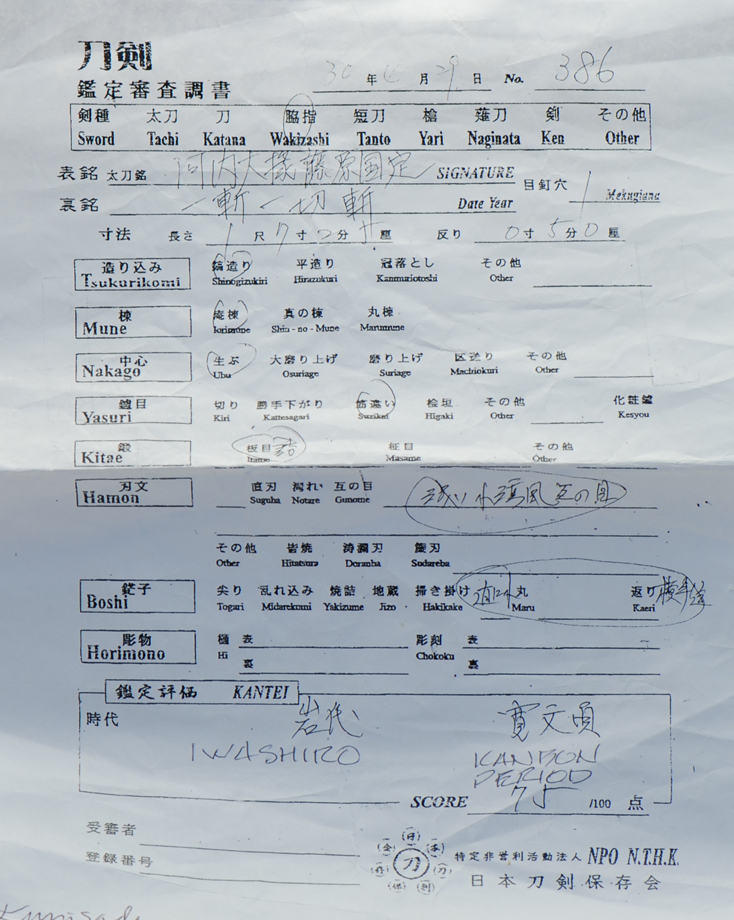A very unique long wakazashi by the 2nd generation Kunisada with a cutting test. The papers put this sword in the Jokyo era (1684-1688). The majority of cutting test blades are katana. The fact that this is a cutting test wakazashi makes for a great collectable sword. The kanji read “cut (through everything) with a single blow”. The reading is: ichizan-sureba issaizan (一斬一切斬)
This sword is a great candidate for restoration signed “Kawachi no Daijo FujiWara KuniSada” with a cutting test. This sword has all the attributes to make for a wonderful restoration. It has a gunome midare hamon with an itame and mokume hada. The boshi is ko-maru. Its very sound and has no fatal flaws. After polish it will look completely different and even more beautiful. We recommend a fresh polish, shirasaya and tsunagi for koshirai. This blade, fully restored with mounts and papers would truly make for a jewel in a collection.
The mounts are of quality with a deep samurai feel to them and are not meant to be flashy. They are all origen with no restoration and date back to the late edo era.
The smith:KUNISADA (国定), 2nd gen., Kanbun (寛文, 1661-1673), Ōshū – “Kawachi no Daijō Fujiwara Kunisada” (河内大掾藤原国定), “Kunisada” (国定), real name Furukawa Mago´emon (古川孫右衛門), he signed his name initially with the characters (国貞), received the honorary title Kawachi no Daijō during the Manji era (万治, 1658-1661), and died in the second year of Genroku (元禄, 1689), suguha, notare, gunome-midare, wazamono, chū-saku
Notes on cutting test:
During the Edo period, only the most skilled swordsmen were chosen to test swords, so that the swordsman’s skill was not a variable in determining how well the sword cut. The materials used to test swords varied greatly. Some substances were wara (rice straw), goza (the top layer of tatami mats), bamboo, and thin steel sheets.
In addition, there were a wide variety of cuts used on cadavers and occasionally convicted criminals, from tabi-gata (ankle cut) to O-kesa (diagonal cut from shoulder to opposite hip). The names of the types of cuts on cadavers show exactly where on the body the cut was made. Older swords can still be found today that have inscriptions on their nakago that say things such as, “5 bodies with Ryu Guruma (hip cut)”. Such an inscription, known as a tameshi-mei or saidan-mei (cutting signature) would add greatly to a sword’s value, compensating the owner somewhat for the large sums of money typically charged for the test.
Aside from specific cuts made on cadavers, there were the normal cuts of Japanese swordsmanship, i.e. downward diagonal (Kesa-giri), upward diagonal (Kiri-age or Gyaku-kesa), horizontal (Yoko or Tsuihei), and straight downward (Jodan-giri, Happonme, Makko-giri, Shinchoku-giri or Dottan-giri).
There is an apocryphal story of a condemned criminal who, after being told he was to be executed by a sword tester using a Kesa-giri cut, calmly joked that if he had known that was going to happen, he would have swallowed large stones to damage the blade.
A complete koshirae . These mounts are with Dragon theme. Very nice shakudo and copper Fuchi/Kashira intricately carved. The ito is black with unique menuki of 3 tsuba on each side. The Tsuba is of a fluted design in iron. It has a dragon kodzuka to match. The saya is a black lacquer with kashezuno. a complete package for restoration.
The legend of the Dragon chasing the pearl varies and an example follows:
Many Chinese believed the dragon held, or at least chased, the sun, and many drawings depict this as a flaming red ball. However, over the years, this sun changed color from red to a silvery-pearl color, and gradually the ball came to be considered a flaming pearl, known as the night shining pearl. It is with this that the dragon is almost invariably associated in art.
The link between serpentine shaped dragons and the pearl is reflected in a legend that states that Chi Liang, the Marquis of Sui, who was a Minister of State, was out walking one day, and found a wounded snake to which he gave medicine and saved its life. Sometime later, he saw the snake with a brilliant pearl in its mouth. The snake said ‘I am the son of His Majesty the Dragon, and I am indebted to you for the preservation of my life, and I have brought this pearl to thank you for your kindness.’ The Minister accepted the pearl and, being a dutiful subject, presented it to his sovereign, who placed it in his hall.
If you are interested in having the restoration done by Mr. Becerra. He will push this restoration up to the middle of his waiting list for polishing. Restoration costs will be paid when work is compleated.
- Mei: Kawachi no Daijo Fujiwara Kunisada (with a one body cut on other side)
- Date: Jokyo (1684-1688)
- Nagasa: 20-1/4 inches
- Sori: 16.5 mm
- Width at the ha-machi: 30.8 mm
- Width at the yokote: 21.9 mm
- Thickness at the mune-machi: 7.0 mm
- Construction: Shinogi zukuri
- Mune: Iori
- Nakago: Ubu
- Kitae: Itame/mokume
- Hamon: Midare Gunome
- Boshi: Maru
- Condition: Old polish
(shipping and insurance included)
Email us if your interested in this item and remember to include the order number for this item: fss-795.
Click to Enlarge Image
This is the work sheet. Official papers should be in soon and will be sent to new owner.
For Sale
























